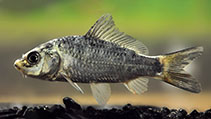| Family: |
Cyprinidae (Minnows or carps), subfamily: Cyprininae |
| Max. size: |
120 cm TL (male/unsexed); max.weight: 40 kg; max. reported age: 38 years |
| Environment: |
benthopelagic; freshwater; brackish; pH range: 6.5 - 9; dH range: 10 - 15; depth range 0 - 29 m, potamodromous |
| Distribution: |
Europe to Asia: Black, Caspian and Aral Sea basins. Introduced throughout the world. Wild stocks are only present naturally in rivers draining to the Black, Caspian and Aral Sea (Ref. 59043). A reophilic wild population in the Danube is assumed to be the origin of the European species; this population is now under threat (Ref. 13696). |
| Diagnosis: |
Dorsal spines (total): 3-4; Dorsal soft rays (total): 17-23; Anal spines: 2-3; Anal soft rays: 5-6; Vertebrae: 36-37. Diagnosed from other cyprinid species in Europe by having the following characters: 2 pairs of barbels; dorsal fin with 15-20½ branched rays; caudal fin deeply emarginate (Ref. 59043). Pharyngeal teeth 1, 1, 3:3, 1,1, robust, molar-like with crown flattened or somewhat furrowed. Scales large and thick. `Wild carp ' is generally distinguished by its less stocky build with height of body 1:3.2-4.8 in standard length. Very variable in form, proportions, squamation, development of fins, and color. Caudal fin with 3 spines and 17-19 rays (Ref. 2196). Last simple anal ray bony and serrated posteriorly; 4 barbels; 17-20 branched dorsal rays; body grey to bronze (Ref. 43281). Also Ref. 3398, 3410. |
| Biology: |
Inhabits warm, deep, slow-flowing and still waters such as lowland rivers and large, well vegetated lakes (Ref. 59043). Hardy and tolerant of a wide variety of conditions but generally favor large water bodies with slow flowing or standing water and soft bottom sediments. Thrive in large turbid rivers (Ref. 1998). Most active at dusk and dawn. Both adults and juveniles feed on a variety of benthic organisms and plant material. Breeds along shores or in backwaters. Adults often undertake considerable spawning migration to suitable backwaters and flooded meadows. Larvae survive only in very warm water among shallow submerged vegetation (Ref. 59043). Occurs at depths of <30m (Ref. 120613) and found sucking in floating insects at the surface (Ref. 120823). River regulation and hybridization with domesticated stocks, East Asian congeners and their hybrids have caused continuous decline of wild populations (Ref. 59043). Utilized fresh and frozen (Ref. 9987). Aquarium keeping: in groups of 5 or more individuals; minimum aquarium size >200 cm; not recommended for home aquariums (Ref. 51539). |
| IUCN Red List Status: |
Vulnerable (VU); Date assessed: 01 January 2008 (A2ce) Ref. (130435)
|
| Threat to humans: |
potential pest |
Source and more info: www.fishbase.org. For personal, classroom, and other internal use only. Not for publication.

